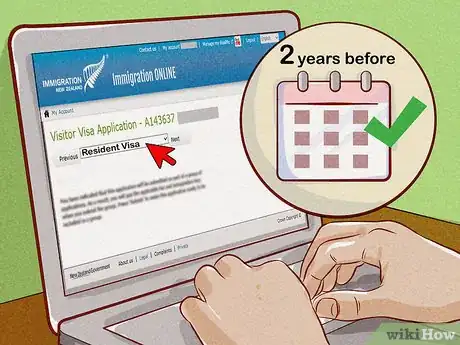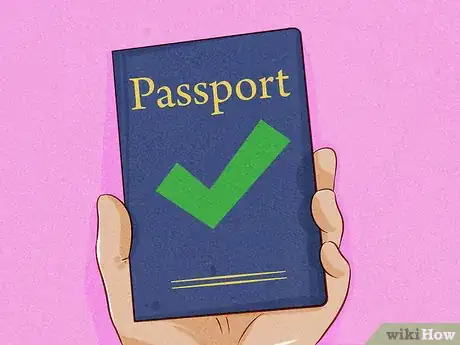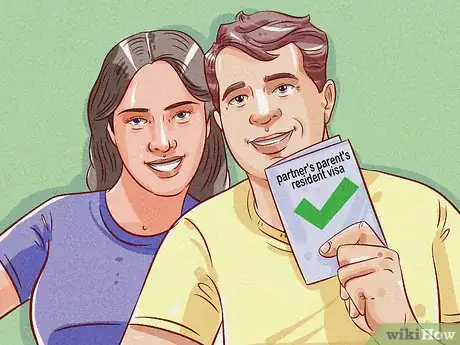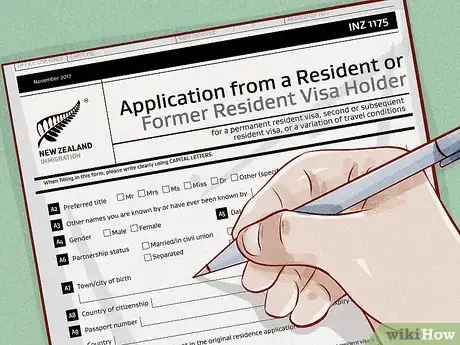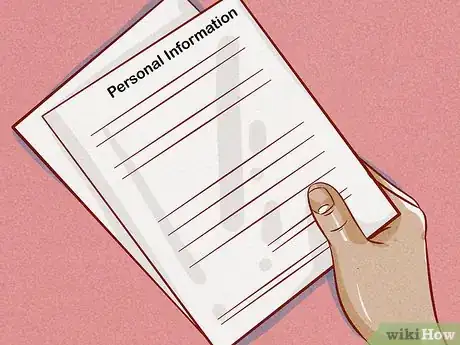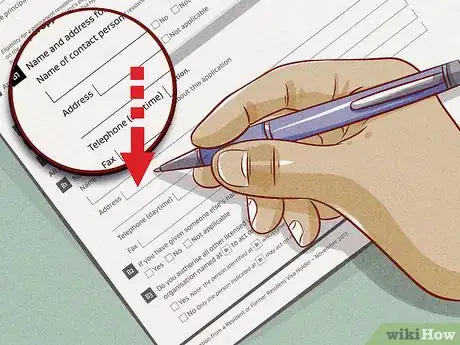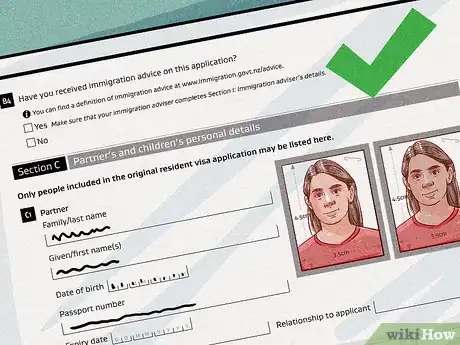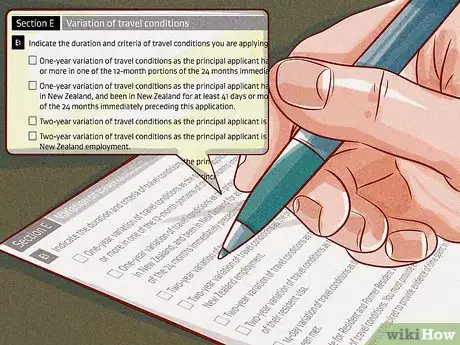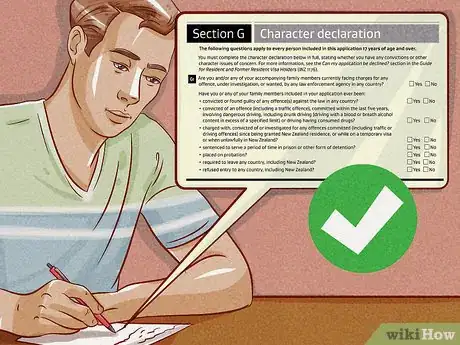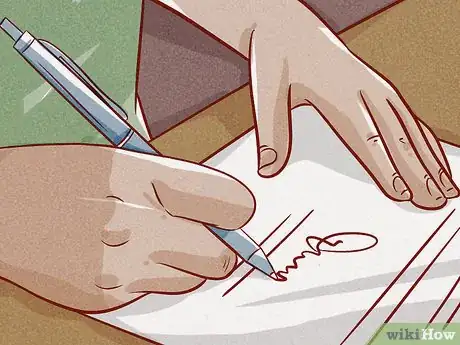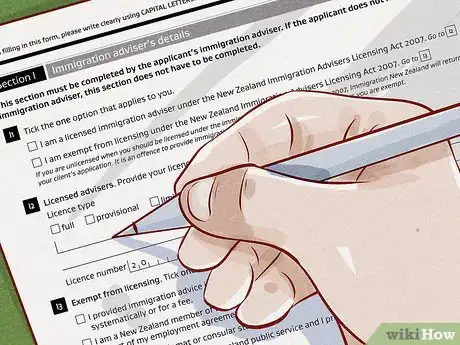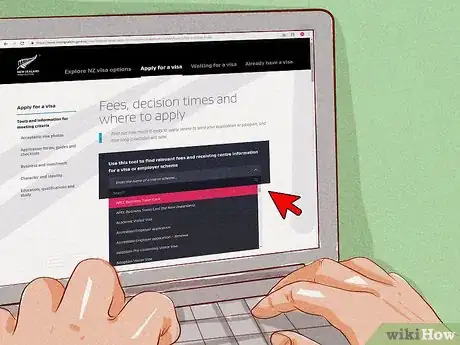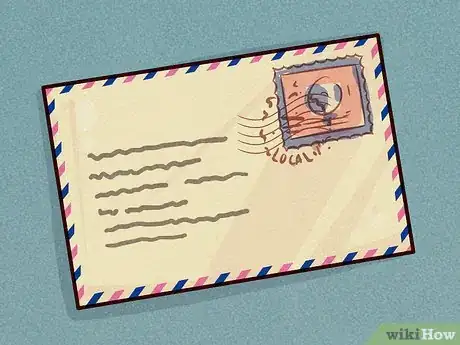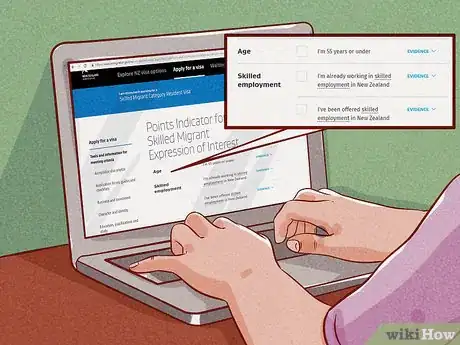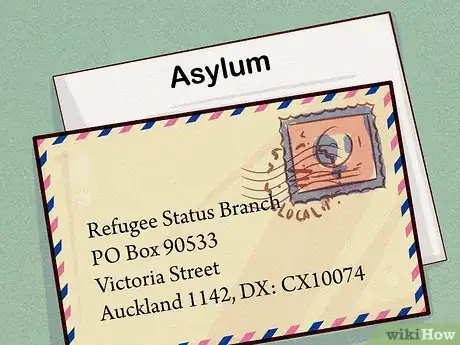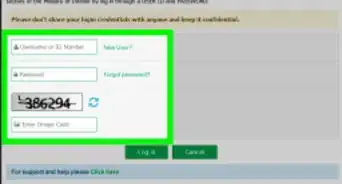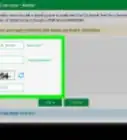This article was co-authored by wikiHow staff writer, Danielle Blinka, MA, MPA. Danielle Blinka is a Writer, Editor, Podcaster, Improv Performer, and Artist currently living in Houston, TX. She also has experience teaching English and writing to others. Danielle holds a Bachelor of Arts in English, Bachelor of Arts in Political Science, Master of Arts in English with a concentration in writing, and Master of Public Administration from Lamar University.
There are 13 references cited in this article, which can be found at the bottom of the page.
This article has been viewed 26,582 times.
Learn more...
Getting a permanent residency visa will allow you to live and work in New Zealand (Aotearoa) for as long as you'd like. Plus, you can travel outside New Zealand and return without having to apply for a new visa. You will become eligible for permanent residency after you have lived in New Zealand for 2 years under any type of resident visa. Once 2 years have passed, you can fill out an application for permanent residency, which should be processed within 21 calendar days. Alternatively, you may qualify for direct permanent residency if you are a skilled worker, a partner of a citizen, or a refugee.
Steps
Gaining Eligibility with a Resident Visa
-
1Get a resident visa at least 2 years before you apply for permanent residency. A resident visa allows you to live in New Zealand, though you may not be able to return if you leave the country. A resident visa is often your first step to gaining permanent residency. Apply for your visa by submitting the appropriate form for your visa to New Zealand Immigration. You'll need to submit your personal information and employment information, as well as your passport information. For an initial visa, you may be able to apply online, since you won't be on New Zealand soil. Immigration officials will review your application and issue a decision.[1] Here are the types of resident visas available:[2]
- Skilled Migrant Resident Visa - This visa allows individuals with specialized education and skills to work in New Zealand.
- Partner of a New Zealander Resident Visa - This visa allows an individual who's in a romantic relationship with a New Zealand citizen to live in the country with their partner.
- Long Term Skill Shortage List Resident Visa - This visa allows people who can do hard-to-fill jobs a chance to work in New Zealand.
- Parent Retirement Resident Visa - This visa allows parents of a New Zealand resident or citizen the opportunity to join their child in New Zealand once they've retired.
- Talent Resident Visa - This is a work visa given to an individual who has a job offer.
- Dependent Child Resident Visa - This visa is provided to children of New Zealand residents or naturalized citizens.
- Investor 2 Resident Visa - This visa is available to people who have business experience and at least NZ $3 million in assets.
- Entrepreneur Resident Visa - This visa is available to people who've legally operated a business in New Zealand for at least 6 months.
- Samoan Quota Resident Visa - This visa is available to Samoan residents who've entered a drawing to live in New Zealand. If your name is drawn, you receive a visa.
- Pacific Access Category Resident Visa - This visa is available to Pacific Islanders who've won a lottery to live in New Zealand.
- Second or Subsequent Resident Visa - This visa allows you to stay in New Zealand after your initial resident visa has passed.
- Religious Worker Resident Visa - This visa allows people to do religious work in New Zealand.
- Investor 1 Resident Visa - This visa is for individuals who are investing NZ $10 million in New Zealand over the next 3 years.
- Talent Resident Visa - This visa allows people who are skilled in arts, sports, or culture the opportunity to live in New Zealand.
- Australian Resident Visa - This visa is available to Australian citizens.
- Community Sponsored Refugee Resident Visa - This visa is available to refugees who've gotten a local New Zealand community to sponsor them.
- Intercountry Adoption Resident Visa - This visa is available to people who are adopted from oversees.
- Pitcairn Islander Resident Visa - This visa is for Pitcairn Islanders who've been offered employment in New Zealand.
- Refugee Family Support Resident Visa - This visa will allow you to stay in New Zealand as a refugee if your family member is a refugee who already has resident status in New Zealand.
- South Island Contribution Resident Visa - This visa is for people who've spent at least 2 years working on South Island.
-
2Live in New Zealand under a resident visa for 2 years. In most cases, you can’t gain permanent residency unless you’ve lived in New Zealand for at least 24 months under a residence visa. You might have your residence visa to work, study, or live with a partner who is a citizen or resident.
- If you haven’t lived in New Zealand as a resident for 2 years, you may be eligible for another visa, such as a work visa or study visa. Although you won't have permanent residency, you'll be able to live in New Zealand under one of these visas.
Advertisement -
3Fulfill any conditions of your resident visa, if applicable. A common condition of your visa is to keep it in a valid passport. However, you may have other conditions, as well. Go over your personal documents to see if you have any unmet conditions of your resident visa.
- For example, you might have a condition on your work visa that you can only work for a specific employer or in a specific trade. If you have a partnership visa, you may have a condition on your visa that you remain in your relationship.[3]
- You likely won’t have any special conditions on your visa. However, officials will want to make sure you followed all of the rules provided to you, such as not overstaying your visa or traveling outside the country without permission.
-
4Show commitment to New Zealand in 1 of the 5 approved ways. This shows immigration officials that you have a reason to be in the country. Here are the 5 ways you can show you’re committed to New Zealand:[4]
- You stayed in New Zealand for at least 184 days during each of the 2 years before you apply.
- You have New Zealand tax residence status.
- You’ve invested at least NZ$1,000,000 in New Zealand.
- You’ve opened a business in New Zealand in the past year or purchased at least a 25% stake in an existing business.
- You established New Zealand as your home by buying a home and maintaining employment for at least 9 months in the past 2 years.
-
5Check for an exception if you were originally included on someone else's visa. You are considered a non-principal applicant if you came to New Zealand under someone else's visa application. For example, you may have come to New Zealand on a partner's or parent's resident visa. If this is the case, you are usually required to gain permanent residency through their application. However, you may gain an exception if your situation meets one of the following criteria:[5]
- You can prove you separated from or divorced the principal applicant.
- You’ve gotten a protection order against the principal applicant.
- The principal applicant was convicted of an offence against you or your dependent.
- The principal applicant has died.
- The principal applicant has become a New Zealand citizen.
Completing Your Permanent Residency Application
-
1Fill out an Application from a Resident or Former Resident Visa Holder. This form is used to apply for permanent residency, an additional residence visa, or travel variations. Write in English, printing clearly. Use all capital letters when writing out names and words.[6]
- In most cases, you'll need to mail your form or deliver it in person. You'll be assigned a receiving office based on your country of origin and where you currently live. If you live in a certain area, such as the United States, you may also be able to submit your application online. You'll find out where your receiving office is when you enter your information on the application fee calculator.
- You can find the application form here: https://www.immigration.govt.nz/documents/forms-and-guides/inz1175.pdf
-
2Attach 2 portrait photos that meet the visa requirements. Your application must include 2 photos of you taken within the past 6 months. Take your photos in front of a plain, light colored background that isn’t white. Wear plain clothes, and look directly at the camera. Although you can have a friend take the photos, immigration officials prefer professional photographs.
- If you’re sending in a paper application, your photo must be 35 millimetres (1.4 in) wide by 45 millimetres (1.8 in) high.
- If you're able to apply online, your picture’s file size should be between 500KB and 3MB. The dimensions must be between 900 x 1200 pixels or 2250 x 3000 pixels.
- Your photo can’t be a selfie.[7]
-
3Provide your personal information. You’ll list your title, name, birthdate, sex, and partnership status. Then, explain where you were born, list your passport information, and indicate if you were the principal applicant on your original residence application.[8]
- If your partner is a citizen, you’ll indicate that on this section of the application.
-
4List your contact details. This includes your address, phone number, fax, and email. In this section, you'll be asked to check a box indicating if you received advice while filling out the form. You can also choose to designate someone to act in your place, such as an adviser or friend, in this section.[9]
- If you don’t have an address or phone number where you can be contacted, you can provide someone else’s information that immigration officials can use to find you. You may designate this person to act on your behalf, as well.
-
5Include your partner and dependents' information and photos, if applicable. You can only include your partner and dependents if they were on your original residence visa. Provide each person’s name, date of birth, passport information, and relationship to you. Then, attach 2 passport-style portraits of each family member.[10]
- Follow the same photo guidelines as those listed above.
- If you have immediate family members that aren’t included in this application, you just need to list them. This includes your partner, children, siblings, and parents. Provide their name, birthdate, current country of residence, nationality, and relationship to you.
-
6Check the appropriate boxes indicating you meet the eligibility requirements. Section D of the application asks you to verify that you meet the basic qualifications to be a permanent resident. If you’ve had a residence visa for at least 24 months, you’ll indicate how you’ve shown your commitment to New Zealand. Then, check “yes” that you have met the conditions and requirements of your visa.[11]
- You will need to provide evidence of your commitment to New Zealand unless the relevant records are government records. You don't need to prove that you live in New Zealand or have tax residence status, as this is public record. However, submit your investment records to show you've invested in New Zealand or your business records to show you're a business owner. If you've set up a home base in New Zealand, submit your house deed and your employment records.
-
7Select what type of travel variations you want if you don’t get permanent residency. The same form is used for both permanent residency and travel variations that allow you to travel out of New Zealand and return. If you aren’t eligible for permanent residency, you might still receive additional travel variations, which expand your freedoms as a resident. Select the type of travel variations that would help you.[12]
- You can ask for a 1-year travel variation, a 2-year travel variation, or a 14-day travel variation. This allows you to leave New Zealand for this period of time and then return under your current visa.
-
8Complete a character declaration for each person on the application. This includes yourself and anyone you included under your partner and dependents section. If you answer yes to any questions, provide full details about what happened in the space provided or on an extra sheet of paper that you'll attach to the application. Check "yes" or "no" if you or your family members have:[13]
- Been investigated for a crime.
- Been convicted of a crime.
- Been sentenced to jail or detention.
- Been put on probation.
- Been required to leave a country.
- Been refused entry to a country.
- Been refused a visa.
- Participated in a terrorist organization.
- Participated in the illicit drug trade.
- Participated in a criminal organization.
- Participated in a hate group.
-
9Verify that everything in your application is true and correct. Sign and date your application indicating that you are being truthful. Your signature also allows immigration officials to access your records and check that your application information is correct.[14]
- If you included a partner on your application, they'll need to sign and date it, as well.
- Dependent children who are under the age of 18 do not need to sign the application. However, dependent children who are over the age of 18 and are included on your application for a resident visa must sign and date the application.
-
10Give information about your adviser or assistant, if you had one. You must indicate if you had someone help you with your application, such as an immigration adviser or friend. Provide this person’s name and information. For an immigration adviser, you’ll need to give their license number or their exemption criteria, if they don’t have a license. If you received assistance from anyone else, they’ll need to sign their name verifying that they helped you.[15]
- For example, you might have worked with a translator or someone who helps you keep up with your paperwork. That person needs to sign your application on the appropriate line.
-
11Determine your application fees using a fee calculator. The amount of your fees will depend on your nationality and country of residence. You can pay your fees using a credit card, personal check, or cash.[16]
- For example, a United States citizen who is currently living in New Zealand would pay NZ$210 as an application fee.
- Don’t send cash through the mail, as it could get lost or stolen during transit.
- You cannot pay your fees with a money order.
- You can calculate your fee here: https://www.immigration.govt.nz/new-zealand-visas/apply-for-a-visa/tools-and-information/tools/office-and-fees-finder
-
12Mail or deliver your application and payment to your assigned receiving center. Your receiving center will be assigned to you based on your nationality and where you currently live. You'll receive this information from the fee calculator. You can choose to mail in your application or deliver it in person. If you mail the application, you’ll be charged a service fee and a courier fee.[17]
- As an example, a United States resident who is mailing their application would pay a USD$37 service fee and a USD$30-60 courier fee on top of their application fee.
- In some areas, you can submit your application online. It depends on where you live. If you can submit your application online, you’ll receive that information along with the physical address for your designated processing center.
Qualifying for Direct Permanent Residency
-
1Use a points calculator to determine if you qualify as a skilled worker. If you have at least 100 points, send an Expression of Interest (EOI) to the New Zealand government. Immigration officials will review your form. If you may qualify for residency, they'll send you an application form to fill out and send back to them.[18]
- Points are granted based on your age, skill level, and job opportunities. At a minimum, you are required to be under 55 years of age, speak fluent English, and have a job or job offer. You’ll gain additional points for having job qualifications, like a professional degree, and prior work experience. You’ll receive extra points if you plan to work outside Auckland, you make at least twice the median income, or you have a skill that’s in short supply.
- You can find the points calculator here: https://www.immigration.govt.nz/new-zealand-visas/apply-for-a-visa/tools-and-information/tools/points-indicator-smc-28aug
- Get the EOI form here: https://www.immigration.govt.nz/documents/forms-and-guides/inz1100.pdf
-
2Apply for residence based on partnership if your partner is a citizen. You may qualify for residence after you've been in a relationship with a New Zealand citizen for at least 12 months and you're living together at the time you apply. Your partner will need to submit a Form INZ 1178 Partnership Support Form for Residence on your behalf. Immigration officials will review your applications and ask for materials that show your relationship is real.
- You'll likely need to prove your relationship by providing photos of you two together, as well as documentation of your relationship timeline. This might include items like cards, letters, and text messages. Immigration officials might also ask to see mail sent to both of you at the same address, evidence of shared bills, or bank statements from a shared account.[19]
- Additionally, you may be able to submit letters from friends and relatives who are willing to state on record that they've observed you and your partner behaving as a couple. These friends and relatives should have a close relationship with you and your partner, but they don't need to be New Zealand residents or citizens.
- If you and your partner can’t prove you’ve been together long enough, you can still get a visa to live in New Zealand. You may be able to get a partnership visa, work visa, or study visa. It will just take you longer to attain residency status.
- You can find form INZ 1178 here: https://www.immigration.govt.nz/documents/forms-and-guides/inz1178.pdf
-
3Apply for asylum if you’re a refugee and currently in New Zealand. You can apply in person or in writing. Then, submit a written statement and attend your asylum interview. The Refugee Status Branch will provide you a report about your claim and interview, which you can correct if needed. Then, you'll get one more opportunity to file support for your claim before a final decision is made.[20]
- The Refugee Status Branch will base their decision on your application, statement, and interview. If you’re approved for asylum, you can go directly to permanent residency. However, you may be deported if your application is rejected. You must show a reason why you are afraid of returning to your home country.
- You can find an application in your native language here: https://www.immigration.govt.nz/audiences/supporting-refugees-and-asylum-seekers/asylum-seekers
- You can send your application to the following address:
Refugee Status Branch
PO Box 90533
Victoria Street
Auckland 1142, DX: CX10074
References
- ↑ https://www.immigration.govt.nz/new-zealand-visas/apply-for-a-visa
- ↑ https://www.immigration.govt.nz/new-zealand-visas/options/live-permanently/all-resident-visas
- ↑ https://www.immigration.govt.nz/new-zealand-visas/apply-for-a-visa/tools-and-information/general-information/interim-visa-conditions
- ↑ https://www.immigration.govt.nz/new-zealand-visas/apply-for-a-visa/tools-and-information/general-information/commitment-to-new-zealand
- ↑ https://www.immigration.govt.nz/new-zealand-visas/apply-for-a-visa/tools-and-information/support-family/non-principal-exceptions
- ↑ https://www.immigration.govt.nz/documents/forms-and-guides/inz1175.pdf
- ↑ https://www.immigration.govt.nz/new-zealand-visas/apply-for-a-visa/tools-and-information/acceptable-photos
- ↑ https://www.immigration.govt.nz/documents/forms-and-guides/inz1175.pdf
- ↑ https://www.immigration.govt.nz/documents/forms-and-guides/inz1175.pdf
- ↑ https://www.immigration.govt.nz/documents/forms-and-guides/inz1175.pdf
- ↑ https://www.immigration.govt.nz/documents/forms-and-guides/inz1175.pdf
- ↑ https://www.immigration.govt.nz/documents/forms-and-guides/inz1175.pdf
- ↑ https://www.immigration.govt.nz/documents/forms-and-guides/inz1175.pdf
- ↑ https://www.immigration.govt.nz/documents/forms-and-guides/inz1175.pdf
- ↑ https://www.immigration.govt.nz/documents/forms-and-guides/inz1175.pdf
- ↑ https://www.immigration.govt.nz/new-zealand-visas/apply-for-a-visa/tools-and-information/tools/office-and-fees-finder
- ↑ https://www.immigration.govt.nz/documents/forms-and-guides/inz1175.pdf
- ↑ https://www.immigration.govt.nz/new-zealand-visas/apply-for-a-visa/tools-and-information/tools/points-indicator-smc-28aug
- ↑ https://www.newzealandshores.com/partnership-visas/
- ↑ https://www.immigration.govt.nz/audiences/supporting-refugees-and-asylum-seekers/asylum-seekers
- ↑ http://skillshortages.immigration.govt.nz/assets/uploads/immediate-skill-shortage-list.pdf
- ↑ https://www.immigration.govt.nz/new-zealand-visas/apply-for-a-visa/tools-and-information/tools/office-and-fees-finder
- ↑ https://www.immigration.govt.nz/new-zealand-visas/apply-for-a-visa/tools-and-information/character-and-identity
